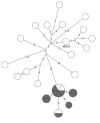Statistical Method to Detect Tuberculosis Outbreaks among Endemic Clusters in a Low-Incidence Setting
- PMID: 29460749
- PMCID: PMC5823347
- DOI: 10.3201/eid2403.171613
Statistical Method to Detect Tuberculosis Outbreaks among Endemic Clusters in a Low-Incidence Setting
Abstract
We previously reported use of genotype surveillance data to predict outbreaks among incident tuberculosis clusters. We propose a method to detect possible outbreaks among endemic tuberculosis clusters. We detected 15 possible outbreaks, of which 10 had epidemiologic data or whole-genome sequencing results. Eight outbreaks were corroborated.
Keywords: United States; bacteria; endemic clusters; genotype; low-incidence setting; molecular epidemiology; outbreaks; respiratory infections; statistical method; tuberculosis and other mycobacteria.
Figures


References
-
- Centers for Disease Control and Prevention. Reported tuberculosis in the United States, 2016. Atlanta: US Department of Health and Human Services, CDC; 2017 [cited 2017 Dec 18]. http://www.cdc.gov/tb/statistics/reports/2016/default.htm
Publication types
MeSH terms
LinkOut - more resources
Full Text Sources
Other Literature Sources
Medical

